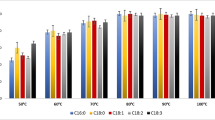Abstract
Buah merah oil and red palm oil are red colored and unrefined edible oils. Because of this color characteristic, measuring acid value by titration method can be uncertain and subjective, so more accurate and objective methods are needed. Gas chromatography-flame ionization detector (GC-FID) and high-performance liquid chromatography-evaporative light scattering detector (HPLC-ELSD) methods were developed to determine acid value in 3 buah merah oils and 1 red palm oil by measuring free fatty acid contents. The acid value was high in the order of titration > GC-FID > HPLC-ELSD in all samples. GC-FID method showed accurate and reliable results, whereas HPLC-ELSD showed rough data partly due to the non-linear standard curve and high limit of detection. Difference in acid value between titration method and GC-FID might be due to unrefined components that reacted with KOH titration solution. GC-FID can be used measuring free fatty acid contents in red colored oils.



Similar content being viewed by others
References
AOCS. Official methods and recommended practices of the American Oil Chemists’ Society. 17th ed. Method Da 14-48; Cd 3d-63. Champaign: AOCS press (2017)
AOCS. Minimally processed oil. https://www.aocs.org/stay-informed/inform-magazine/featured-articles/minimally-processed-oils-april-2020?SSO=True (2020)
Catanzaro R, Zerbinati N, Solimene U, Marcellino M, Mohania D, Italia A, Antonio A, Marotta F. Beneficial effect of refined red palm oil on lipid peroxidation and monocyte tissue factor in HCV-related liver disease: a randomizer controller study. Hepatobiliary & Pancreatic Diseases International. 15: 165-172 (2016)
Codex. STAN 19–1981. Codex Alimentarius Commission, Standard for edible fats and oils not covered by individual standards (1981)
Dong S, Xia H, Wang F, Sun G. The effect of red palm oil on vitamin A deficiency: A meta-analysis of randomized controlled trials. Nutrients. 9: 1281 (2017)
Fuller ID, Cumming AH, Card A, Burgess EJ, Barrow CJ, Perry NB, Killeen DP. Free fatty acids in commercial krill oils: concentrations, compositions, and implications for oxidative stability. Journal of the American Oil Chemists' Society. 97: 889-900 (2020)
Gim SY, Jung JY, Kwon YJ, Kim MJ, Kim GH, Lee JH. Application of β‐cyclodextrin, chitosan, and collagen on the stability of tocopherols and the oxidative stability in heated oils. European Journal of Lipid Science and Technology. 119: 1700124 (2017)
ISO. Method 660:1996. Animal and vegetable fats and oils—Determination of acid value and acidity. International Organisation for standardisation (1996)
IUPAC. Standard Methods 2.201. Standard Methods for the Analysis of Oils, Fats and Derivatives. 7th ed. International Union of Pure and Applied Chemistry, Oxford, Great Britain: Blackwell Scientific (1991)
Marcato B, Cecchin G. Analysis of mixtures containing free fatty acids and mono-, di-and triglycerides by high-performance liquid chromatography coupled with evaporative light-scattering detection. Journal of Chromatography A. 730: 83-90 (1996)
MFDS, Ministry of Food and Drug Safety, Specification and Guideline for Food Production (2021)
Moh MH, Tang TS, Tan GH. Simultaneous determination of free fatty acids, partial acylglycerols and tocols in palm oil products using high‐performance liquid chromatography. Journal of Food Lipids. 8: 179-190 (2001)
Murtiningrum M, Sarungallo ZL, Mawikere NL. The exploration and diversity of red fruit (Pandanus conoideus L.) from Papua based on its physical characteristics and chemical composition. Biodiversitas Journal of Biological Diversity. 13 (2012)
Nagendran B, Unnithan UR, Choo YM, Sundram K. Characteristics of red palm oil, a carotene-and vitamin E–rich refined oil for food uses. Food and Nutrition Bulletin. 21: 189-194 (2000)
Park YW, Chang PS, Lee JH. Application of triacylglycerol and fatty acid analyses to discriminate blended sesame oil with soybean oil. Food Chemistry. 123: 377-383 (2010)
Sarungallo ZL, Roreng MK, Santoso B. Chemical properties, carotenoid, tocopherol and fatty acid composition of three clones of red fruit (Pandanus conoideus Lam.) oil of different ripening stages. International Food Research Journal. 26 (2019)
Sarungallo ZL, Hariyadi P, Andarwulan N, Purnomo EH, Wada M. Analysis of α-cryptoxanthin, β-cryptoxanthin, α-carotene, and β-carotene of Pandanus conoideus oil by high-performance liquid chromatography (HPLC). Procedia Food Science. 3: 231-243 (2015)
Song JH, Kim SH, Kim JS, Kim MJ, Lee SM, Jang MI, Lee JH. Oxidative properties and moisture content in repeatedly used oils for French fries and breaded chickens during frying. European Journal of Lipid Science and Technology. 119: 1600279 (2017)
Williams MG, MacGee J. Rapid determination of free fatty acids in vegetable oils by gas liquid chromatography. Journal of the American Oil Chemists’ Society. 60: 1507-1509 (1983)
Woo YS, Kim MJ, Lee JH. Correlation of the solid‐fat content in vegetable oils with other parameters during thermal oxidation. Journal of the American Oil Chemists' Society. 95: 1179-1187 (2018)
Woo YS, Kim MJ, Lee JH. Prediction of oxidative stability in bulk oils using dielectric constant changes. Food Chemistry. 279: 216-222 (2019)
Zhang H, Wang Z, Liu O. Development and validation of a GC–FID method for quantitative analysis of oleic acid and related fatty acids. Journal of Pharmaceutical Analysis. 5: 223-230 (2015)
Zhu G, Liu F, Li P, He S, Zhu S, Gao Q, Feng Y. Profiling free fatty acids in edible oils via magnetic dispersive extraction and comprehensive two-dimensional gas chromatography-mass spectrometry. Food Chemistry. 297: 124998 (2019)
Acknowledgements
This work was supported by the National Research Foundation of Korea (NRF) grant (2020R1A2C2006600) funded by the Korean government and High Value added Food Technology Development Program through the iPET (Korea Inst. of Planning and Evaluation for Technology in Food, Agriculture, Forestry and Fisheries) (119029-3).
Author information
Authors and Affiliations
Corresponding author
Ethics declarations
Conflict of interest
The authors declare that they have no known competing financial interests or personal relationships that could have appeared to influence the work reported in this paper.
Additional information
Publisher's Note
Springer Nature remains neutral with regard to jurisdictional claims in published maps and institutional affiliations.
Supplementary Information
Below is the link to the electronic supplementary material.
Rights and permissions
About this article
Cite this article
Choi, H., Kim, C., Choi, H. et al. Development of methods for determining free fatty acid contents in red colored oils. Food Sci Biotechnol 30, 1435–1443 (2021). https://doi.org/10.1007/s10068-021-00964-2
Received:
Revised:
Accepted:
Published:
Issue Date:
DOI: https://doi.org/10.1007/s10068-021-00964-2




